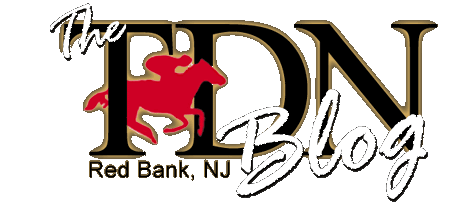We all know about Hansen, Bodemeister, and Union Rags, but the real wiseguy horses this week are Mommie's Luke and Bob's Big Bunch.
Last week, I photographed the workouts of two Thoroughbreds who are prepping for the first Saturday in May. One is a handy bay with a distinctly Northern Dancer-esque neck, eye, and head. His taller stablemate is a powerful chestnut son of Perfect Soul, out of a Hennessy mare.
Both geldings aged out of Kentucky Derby eligibility years ago, and have a new goal in mind. These ex-racehorses are now show jumpers, and this Saturday, they will compete at the AA-rated Garden State Horse Show in the $4,000 Thoroughbred Jumper Classic.
The Garden State Horse Show, in its 61st year, is awarding bonuses and hosting Thoroughbred hunter and jumper classes for the first time, through the support of the New Jersey Thoroughbred Industry, New Jersey Thoroughbred Horsemen’s Association, and the TAKE2 program (an initiative of the New York Thoroughbred Horsemen's Association, the New York Racing Association and the New York Thoroughbred Breeders Inc.).
When I visited two of Saturday's equine competitors at Crewe Hill Stable in Morristown, NJ, and I asked the riders and trainers why we are seeing this renewed attention and support for the Thoroughbred in the show ring, the response was always the same: legendary trainer and chef d’equipe for the United States Equestrian Foundation, USEF, show jumping team, George Morris. His 2011 quote was heard round the equestrian world: “Thoroughbreds are the best. They’re lighter, quicker and more intelligent. The best of any breed is the Thoroughbred horse, the best of that breed is better than any other breed."
In 2010, Morris discussed his impressions of "The State of Our Sport" with Bernie Traurig:
Well, I think we have to start looking inward because we’re just being so passive with outsourcing, outsourcing. The first one, which is the most difficult in a way, would be internal horse supply. Even if people had a couple of mares or went to these places where they take thoroughbreds off the track. If enough people did enough of that you’re talking about a lot of horses. Start looking inward to our vast reservoir and resource of horse flesh here that they’re giving away or sending to “the killers” because there’s just a glut in the market. There are horses out there, there are horses, horses, horses.
Together with a big push from the top of the sport, the racing world has made an organized, concerted effort to support racehorses after their racing careers end. According to New York Thoroughbred Horsemen's Association President Rick Violette Jr., “The welfare of our equine athletes, both during and after their racing careers, is of the utmost importance to the owners and trainers competing at NYRA’s tracks. NYTHA and NYRA have long offered financial support to organizations such as the Thoroughbred Retirement Foundation, but we are now expanding our initiatives. We want to give our retired racehorses the opportunity to find new vocations in different equestrian disciplines. This is our Jobs Program,” Violette added. “Thoroughbreds are healthier and happier when they have jobs to do.”
There is nothing new about the love affair with Thoroughbreds both as racehorses and as sporthorses, but the marriage between both worlds is what is exciting to me. I proudly represented the TDN in Virginia, Maryland, and Pennsylvania for the Retired Racehorse Training Project's Trainer Challenge, and in the future, I hope to see more writers and photographers from racing publications standing alongside me, supporting events and projects like these.
When it comes to responsibility to racehorses both on the track and after retirement, trainers John Forbes and Pat McBurney are walking the walk. Less Is More (show name), aka Lester (barn name), aka Mommie's Luke (Jockey Club name) retired a sound maiden after it became clear that he was not competitive as a racehorse.
Pat's wife, Linda, owns and shows Lester in jumper classes from Saugerties to Wellington. According to Linda, as a racehorse, Lester was always quick out of the gate, which turned out to be a hint of his future talent in the jumper ring.
Lester is about 15.2 hands tall and wears a jaunty "milk moustache" of white on the side of his muzzle. His intelligence, game personality, and playful demeanor make him quite a charismatic horse.
Smithwick (show name), aka Hennessy (barn name), aka Bob's Big Bunch (Jockey Club name) is owned and ridden by professional trainer Melissa Monti. He sold as a yearling for $22,000 but also retired a sound maiden.
When he was in training at the track, he always carried himself more like a sporthorse than a racehorse, and his trainer's keen eyes saw this. Because he was retired sound, Hennessy's future as a show horse is much brighter and his value is higher. Serious competitors are interested in horses off the track, but in order for the horses to be considered for the AA show circuit and be considered for resale projects, they must be sound.
If you'd like to cheer on these horses and riders in their class, you can attend the Garden State Horse Show in Augusta, New Jersey. The class will start around 2pm. And if you're like me, you'll be very pleased to learn that they broadcast the Kentucky Derby at the horse show, so you won't miss a thing. You can root for your Derby horses, as well as Lester and Hennessy.












No comments:
Post a Comment